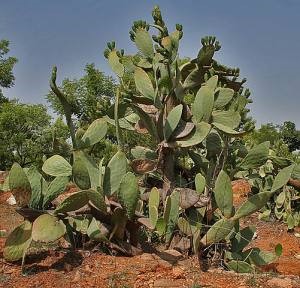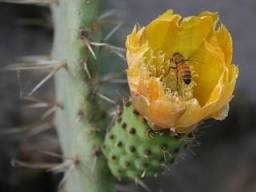Prickly Pear
 Common Name: Prickly pear, cactus pear, nopal, Indian fig opuntia, Barbary fig
Common Name: Prickly pear, cactus pear, nopal, Indian fig opuntia, Barbary fig
Scientific Name: Opuntia ficusindica
Climate: Hot and temperate. It is adapted to hot and dry regions
Plant Description1,2: Plant Description: Nopal is a shrubby plant of the cactaceae (cactus) family, reaching 3.5-5.5 m tall. The stems are capable of branching, emitting flowers and fruits. These stems, or “pads” are flat, oval and of a medium green color. They have two types of spines: some are long and hard, and others are short and fine, kind of like hair. Some types are spineless and don't have the long hard spines, just the short hairy ones.
The flowers from the edges of the pads - It flowers once a year and both the fruit and the flower can be of various colours, from yellow to red. The fruit has a thick, spiny skin with a pulp that is abundant in seeds or pips. The ripe fruit is an oval shaped berry with diameters between five to seven cm, a length of five to eleven cm.
It is native to the American continent and a species native to Mexico, where the largest variety of plants of this species is found.
Cultivation: To grow them, germinate seeds from the fruit and propagate a new plant from an existing one. The cactus stalk must be at least six months old. Leave it standing until it forms what looks like a callus. This takes a week or two in hot weather or longer if the air is humid.
It should be planted in full sun, it can be watered once a week in dry and hot places or once every 15 days in warm and humid places, as this crop does not tolerate excess water. It can grow in sandy, clayey and loamy soils.
The largest amount of production is obtained during the season of higher humidity and temperature (May - September), corresponding these months to the rainy season. Harvesting takes place when the shoots are around 10-15 cm long.
 Uses: The cactus fruits are used to make jams, jellies, nectar, tortillas, etc. Nopal is consumed as a vegetable, it is used for medicinal purposes to treat diabetes, cholesterol and is suitable in diets to lose weight.
Uses: The cactus fruits are used to make jams, jellies, nectar, tortillas, etc. Nopal is consumed as a vegetable, it is used for medicinal purposes to treat diabetes, cholesterol and is suitable in diets to lose weight.
Pests and Diseases: The cottony bug is the main problem with cactus. It is a kind of white cotton powder that if you squeeze it leaves a reddish liquid. In fact, that liquid is used and is used as a dye for fabrics. It is a heavy pest to remove.
References:
- https://www.ecured.cu/Opuntia_ficus-indica
- “Perennial Vegetables” by Eric Toensmeier
En español: Nopal
